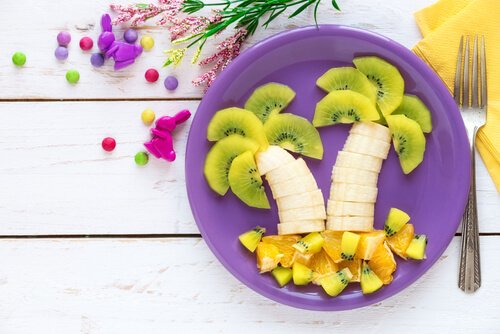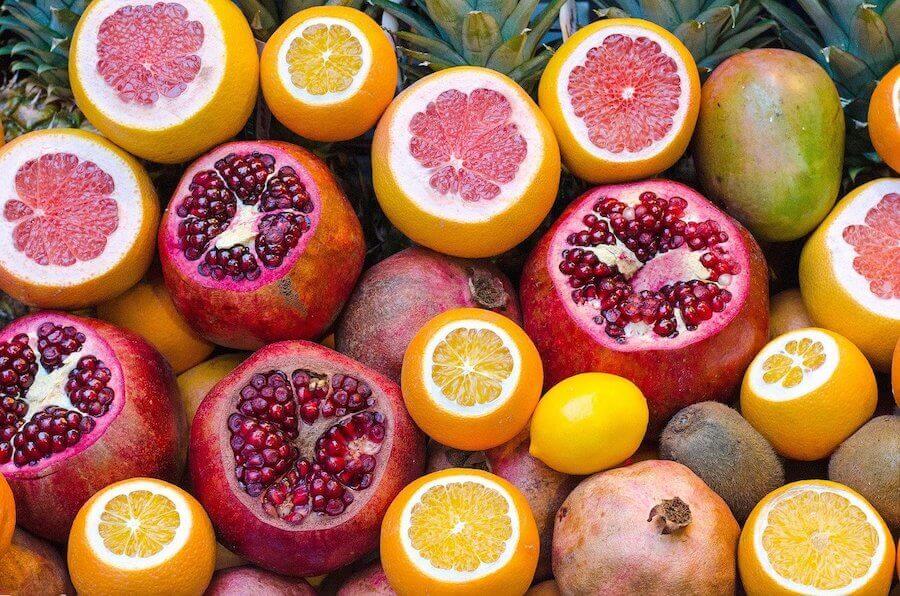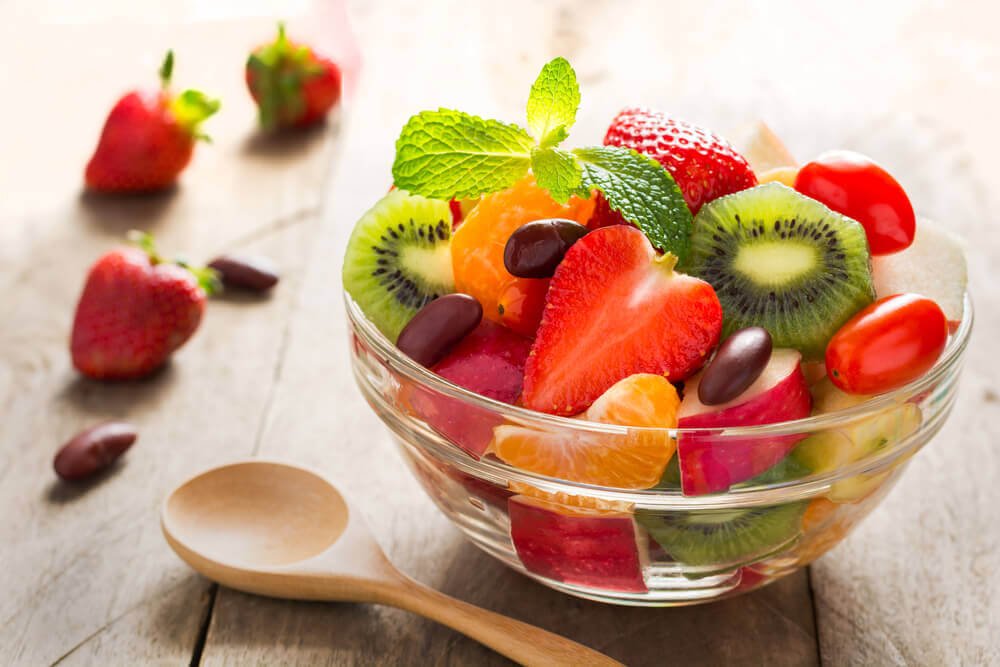4 Myths About Fruits and the Truth Behind Them

There’s a lot of myths out there about food and eating in general. There are especially old and widespread misconceptions about fruits, even though they’re healthy and have a lot of nutritional value. That’s why, in this article, we’ll talk about the biggest myths about fruits.
One of the most common myths about fruits: avoid fruit that’s high in sugar to lose weight
Have you visited an endocrinologist or a nutritionist? Starting in the 80s and 90s, anybody who wanted to lose weight was given a list of forbidden foods. Among these were fruits such as plantains, grapes, figs, and raisins. However, times have changed and scientific evidence shows that there’s no relation between glycemic index and weight loss.
For those who don’t know, the glycemic index is your body’s response to the sugar in food. The higher it is, the faster the blood absorbs it. However, it depends on what you eat. This means that fiber slows this process, which is what happens with fruit. Therefore, you can eat up to three fruit servings a day, because they help the body fight against diabetes, cardiovascular diseases, and obesity.

Diabetics can’t eat fruits
As we previously stated, fruits are made of water and fiber, especially if they’re fresh. Besides, fruit has a lot of minerals and vitamins. It also has glucose and fructose, simple sugars of fast absorption.
If you take into account that last part, you may believe that diabetics can’t process it properly, elevating their sugar levels in the blood. However, as fruits have fiber, they help regulate glucose and the process of absorption.
A glass of juice equals a serving of fruit
When making fruit juice, we don’t get all the fiber from the whole fruit. Thus, the body reacts differently, making the sugar in blood levels go off.
This means that, after two or three hours, you’ll have more risk of suffering from a hypoglycemic attack if you have diabetes after just drinking it, and you’ll feel hungry again. This happens because you’re momentarily filled with liquid.
According to the OPS, juices are sugary and should be consumed in moderation.

It’s best to eat fruits between hours
Have you heard that fruits ferments in your stomach after you eat it? This doesn’t really happen. Usually, those that live by that statement say it’s because you also consume proteins. On the contrary, fruits like pineapples or papaya have digestive enzymes that make it easier to digest proteins. Thus, there’s no reason to eat fruits as dessert for this reason.
Another interesting aspect to take into account, when you’re in the process of losing weight or controlling stress eating, is that it could be useful to eat fruits before eating. Why? Because they’re rich in fiber, water and vitamins. This makes you feel full, and helps you stop eating between meals.
To end this myth, the main reason some people aren’t allowed to eat fruits between meals is because of fructose intolerance. This sugar is present in some vegetables and dried snacks, such as raisins.

Thus, if you eat several fruits high in fructose at the same time, your body saturates, sending the undigested excess right to your intestines. Here, bacteria ferments it, producing digestive symptoms, such as gas, bloating and heaviness.
In conclusion, there are several myths about fruits that aren’t exactly true. It’s generally healthy to eat at least two or three servings of fresh fruit every day to experience all their benefits. Remember, nutrition changes through time and, what can be good today, can be bad the next day. Also, every body is different. That’s why, it’s always a good idea to assess and adapt your diet often.
There’s a lot of myths out there about food and eating in general. There are especially old and widespread misconceptions about fruits, even though they’re healthy and have a lot of nutritional value. That’s why, in this article, we’ll talk about the biggest myths about fruits.
One of the most common myths about fruits: avoid fruit that’s high in sugar to lose weight
Have you visited an endocrinologist or a nutritionist? Starting in the 80s and 90s, anybody who wanted to lose weight was given a list of forbidden foods. Among these were fruits such as plantains, grapes, figs, and raisins. However, times have changed and scientific evidence shows that there’s no relation between glycemic index and weight loss.
For those who don’t know, the glycemic index is your body’s response to the sugar in food. The higher it is, the faster the blood absorbs it. However, it depends on what you eat. This means that fiber slows this process, which is what happens with fruit. Therefore, you can eat up to three fruit servings a day, because they help the body fight against diabetes, cardiovascular diseases, and obesity.

Diabetics can’t eat fruits
As we previously stated, fruits are made of water and fiber, especially if they’re fresh. Besides, fruit has a lot of minerals and vitamins. It also has glucose and fructose, simple sugars of fast absorption.
If you take into account that last part, you may believe that diabetics can’t process it properly, elevating their sugar levels in the blood. However, as fruits have fiber, they help regulate glucose and the process of absorption.
A glass of juice equals a serving of fruit
When making fruit juice, we don’t get all the fiber from the whole fruit. Thus, the body reacts differently, making the sugar in blood levels go off.
This means that, after two or three hours, you’ll have more risk of suffering from a hypoglycemic attack if you have diabetes after just drinking it, and you’ll feel hungry again. This happens because you’re momentarily filled with liquid.
According to the OPS, juices are sugary and should be consumed in moderation.

It’s best to eat fruits between hours
Have you heard that fruits ferments in your stomach after you eat it? This doesn’t really happen. Usually, those that live by that statement say it’s because you also consume proteins. On the contrary, fruits like pineapples or papaya have digestive enzymes that make it easier to digest proteins. Thus, there’s no reason to eat fruits as dessert for this reason.
Another interesting aspect to take into account, when you’re in the process of losing weight or controlling stress eating, is that it could be useful to eat fruits before eating. Why? Because they’re rich in fiber, water and vitamins. This makes you feel full, and helps you stop eating between meals.
To end this myth, the main reason some people aren’t allowed to eat fruits between meals is because of fructose intolerance. This sugar is present in some vegetables and dried snacks, such as raisins.

Thus, if you eat several fruits high in fructose at the same time, your body saturates, sending the undigested excess right to your intestines. Here, bacteria ferments it, producing digestive symptoms, such as gas, bloating and heaviness.
In conclusion, there are several myths about fruits that aren’t exactly true. It’s generally healthy to eat at least two or three servings of fresh fruit every day to experience all their benefits. Remember, nutrition changes through time and, what can be good today, can be bad the next day. Also, every body is different. That’s why, it’s always a good idea to assess and adapt your diet often.
All cited sources were thoroughly reviewed by our team to ensure their quality, reliability, currency, and validity. The bibliography of this article was considered reliable and of academic or scientific accuracy.
- Karl JP, Roberts SB, Schaefer EJ, Gleason JA, Fuss P, Rasmussen H et al (2015). Effects of carbohydrate quantity and glycemic index on resting metabolic rate and body composition during weight loss. Obesity (Silver Spring):23(11): 2190-8.
- Silva KC, Neri Nobre L, Emanuelle de Castro Ferreira Vicente S, Lopes Moreira L, do Carmo Lessa A, Alves Lamounier J(2016). Influence of glycemic index and glycemic load of the diet on the risk of overweight and adiposity in childhood. Rev Paul Pediatr, 34(3): 293-300.
- Christensen AS, Viggers L, Hasselström K, Gregersen S. (2013) Effect of fruit restriction on glycemic control in patients with type 2 diabetes–a randomized trial. Nutr J,12:29.
- Mamluk L, O’Doherty MG, Orfanos P, Saitakis G, Woodside JV, Liao LM et al (2017) Fruit and vegetable intake and risk of incident of type 2 diabetes: results from the consortium on health and ageing network of cohorts in Europe and the United States (CHANCES). Eur J Clin Nutr, 71(1): 83-91.
- Muraki I, Imamura F, Manson JE, Hu FB, Willett WC, van Dam RM et al. (2013). Fruit consumption and risk of type 2 diabetes: results from three prospective longitudinal cohort studies. BMJ, 347.
- Diabetes a la carta. ¿Se puede comer fruta con diabetes? Consultado el 21 de enero de 2020. Disponible en: https://diabetesalacarta.org/preguntas-frecuentes/
- OMS. Nota informativa sobre la ingesta de azúcares recomendada en la directriz de la OMS par adultos y niños. Organización Mundial de la Salud, 2015.
- Julio Basulto (Comer o no comer). Mejor una fruta entera que un zumo. [Actualizado el 8 de septiembre de 2015] Consultado el 21 de enero de 2020. Disponible en: https://comeronocomer.es/los-consejos/mejor-una-fruta-entera-que-un-zumo
- Juan Revenga (Patia diabetes). (2019) No es recomendable sustituir fruta por zumos. Consultado el 21 de enero de 2020. Disponible en: http://www.patiadiabetes.com/no-recomendable-sustituir-fruta-zumos-2/
- Ubois, L.; Farmer, A.; Girard, M. y Peterson,K. Regular sugar-sweetened beverages consumption between meals increases risk of overweight among preschool-aged children. J Am Diet Assoc 2007, 107(6): 924-34.
- Yoshida, Y y Simoes, EJ. Sugar-Sweetened beverage, obesity and type 2 diabetes in children and adolescents: policies, taxation and programs. Curr Diab Rep 2018, 18(6): 31.
- Pérez Aisa, A y Riquelme, A. (n.d.). Intolerancia a la fructosa-sorbitol. AEGASTRO(Asociación Española de Gastroenterologia). [Consultado 14 agosto 2019] Disponible en: https://www.aegastro.es/sites/default/files/archivos/documento-grupo/intolerancia_fructosa_-_sorbitol_0.pdf
- Guía Metabólica. (n.d.). Intolerancia Hereditaria a la Fructosa. [Consultado 14 de agosto de 2019] Disponible en: https://metabolicas.sjdhospitalbarcelona.org/ecm/intolerancia-hereditaria-fructosa-ihf
This text is provided for informational purposes only and does not replace consultation with a professional. If in doubt, consult your specialist.








